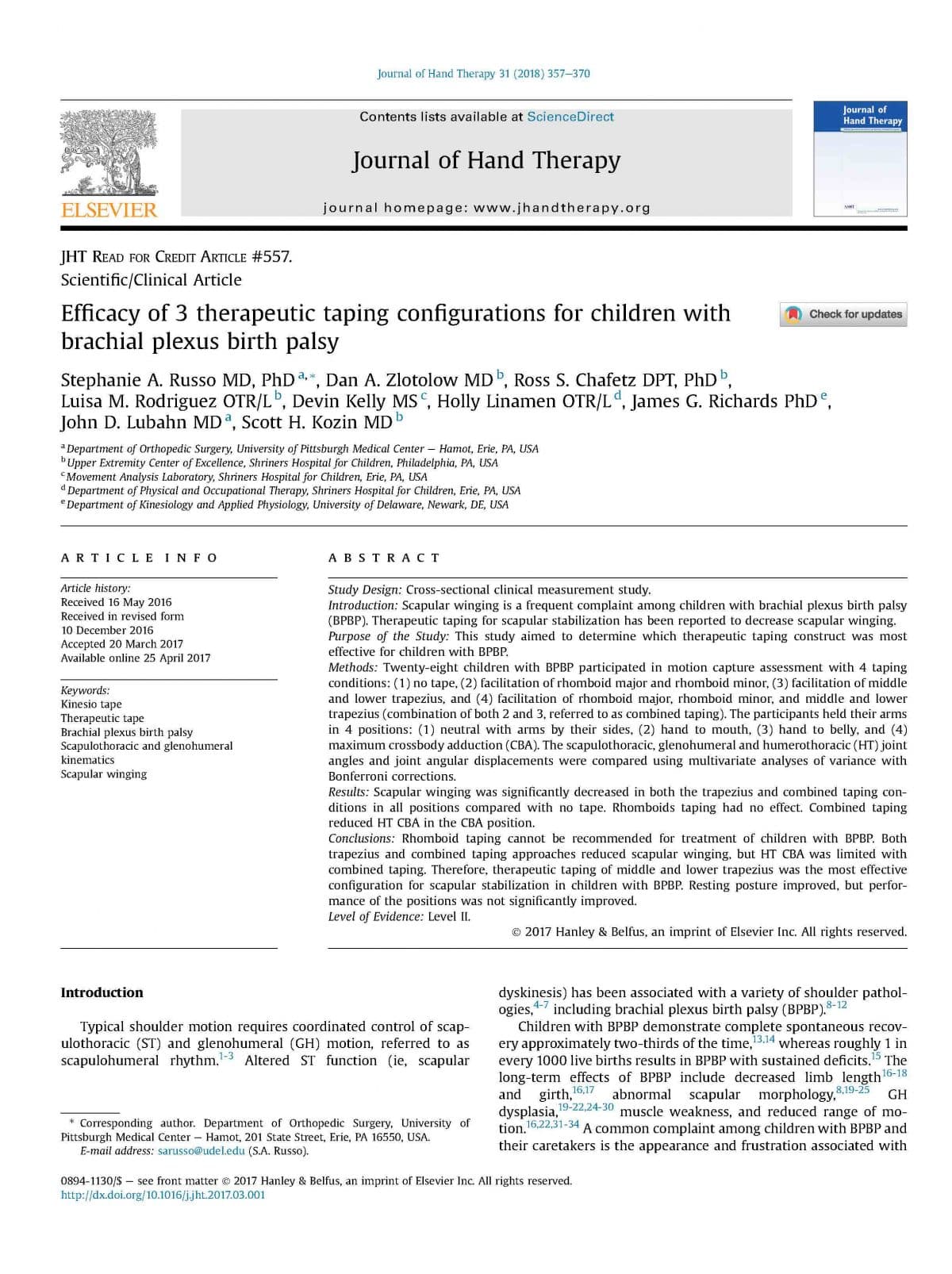JHT READ FOR CREDIT ARTICLE #557.
Scientific/Clinical Article
Efficacy Of 3 Therapeutic Taping Configurations For Children With Brachial Plexus Birth Palsy
Stephanie A. Russo MD, PhD a,*, Dan A. Zlotolow MDb, Ross S. Chafetz DPT, PhD b, Luisa M. Rodriguez OTR/L b, Devin Kelly MS c, Holly Linamen OTR/L d, James G. Richards PhD e, John D. Lubahn MD a, Scott H. Kozin MD b
a Department of Orthopedic Surgery, University of Pittsburgh Medical Center e Hamot, Erie, PA, USA
b Upper Extremity Center of Excellence, Shriners Hospital for Children, Philadelphia, PA, USA
c Movement Analysis Laboratory, Shriners Hospital for Children, Erie, PA, USA
d Department of Physical and Occupational Therapy, Shriners Hospital for Children, Erie, PA, USA
e Department of Kinesiology and Applied Physiology, University of Delaware, Newark, DE, USA
ABSTRACT
Study Design: Cross-sectional clinical measurement study.
Introduction: Scapular winging is a frequent complaint among children with brachial plexus birth palsy (BPBP). Therapeutic taping for scapular stabilization has been reported to decrease scapular winging.
Purpose of the Study: This study aimed to determine which therapeutic taping construct was most effective for children with BPBP.
Methods: Twenty-eight children with BPBP participated in motion capture assessment with 4 taping conditions: (1) no tape, (2) facilitation of rhomboid major and rhomboid minor, (3) facilitation of middle and lower trapezius, and (4) facilitation of rhomboid major, rhomboid minor, and middle and lower trapezius (combination of both 2 and 3, referred to as combined taping). The participants held their arms in 4 positions: (1) neutral with arms by their sides, (2) hand to mouth, (3) hand to belly, and (4) maximum crossbody adduction (CBA). The scapulothoracic, glenohumeral and humerothoracic (HT) joint angles and joint angular displacements were compared using multivariate analyses of variance with Bonferroni corrections.
Results: Scapular winging was significantly decreased in both the trapezius and combined taping conditions in all positions compared with no tape. Rhomboids taping had no effect. Combined taping reduced HT CBA in the CBA position.
Conclusions: Rhomboid taping cannot be recommended for treatment of children with BPBP. Both trapezius and combined taping approaches reduced scapular winging, but HT CBA was limited with combined taping. Therefore, therapeutic taping of middle and lower trapezius was the most effective configuration for scapular stabilization in children with BPBP. Resting posture improved, but performance of the positions was not significantly improved.
Level of Evidence: Level II.
© 2017 Hanley & Belfus, an imprint of Elsevier Inc. All rights reserved.
KEY WORDS: Therapeutic tape, Brachial plexus birth palsy, Scapulothoracic and glenohumeral, kinematics, Scapular winging, rhomboid, trapezius
Article history:
Received 16 May 2016
Received in revised form
10 December 2016
Accepted 20 March 2017
Available online 25 April 2017




